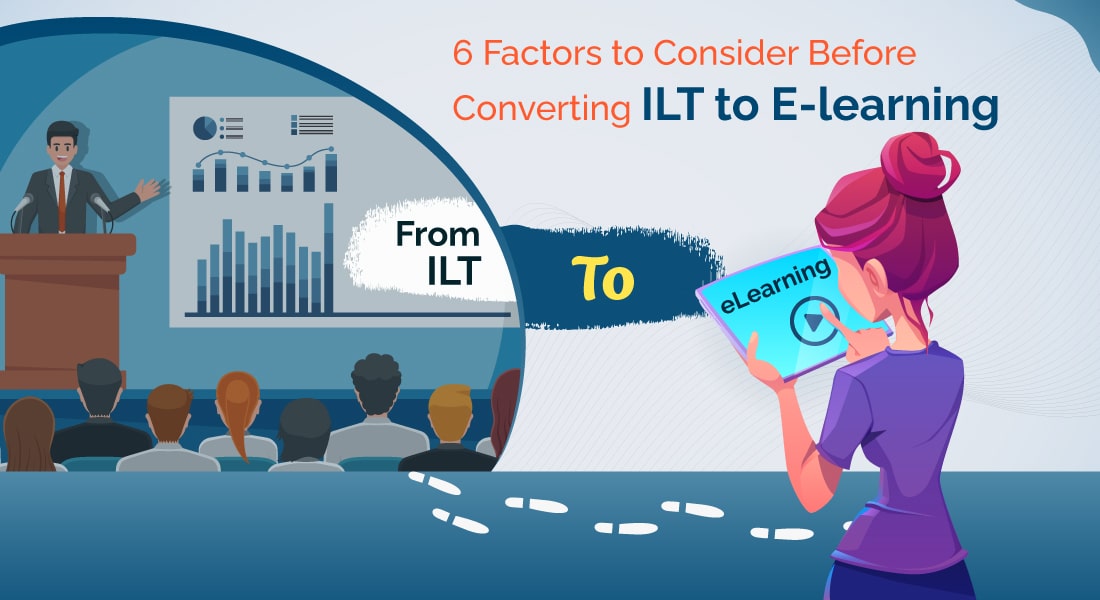6 Critical Considerations before Shifting your ILT to eLearning

Google+ was the fastest social network to reach 10 million users, and it did that within 16 days! (Twitter took 780 days and Facebook 852 days to reach 10 million users.) And what about YouTube? Well, if statistical data is to be believed, more than 500 hours of videos are being uploaded every minute to YouTube, globally. That’s 30,000 hours every hour, 720,000 hours every day!
Why am I talking about Google and YouTube in a blog on training?

Because these numbers show us that an astounding number of people are choosing to spend a mind-boggling amount of time online – either surfing the net looking for information or just hanging out and entertaining themselves! And that makes the online medium a very good option to train your employees, wouldn’t you say?
Find out ways to incorporate social learning in eLearning.
But how easy (or difficult) is it to take your training online? What are the important considerations that will help you decide for or against it?
ILT (instruction-led training) to E-learning Conversion
Consider 6 critical factors before making the transition:
- Business Goals
- Learning Objectives
- Learners
- Subject/Topic
- Training Format
- Available Resources
Key Points to Keep in Mind Before ILT to E-learning Transition
Business Goals: What are the business goals you want to achieve through the training?
Is the goal of the program to:
- Update existing knowledge or develop new skills?
- Make your organization compliant with the latest regulations?
- Give your sales team the ability to sell your recently launched product ahead of the competition?
If you need to train a large number of employees dispersed across the globe at different locations, online methods make more sense than face-to-face training. The online option is especially useful when there are time and budgetary constraints to get employees up to speed with a new situation, scenario, or product.
Learning Objectives: Would the learning objectives be effectively achieved through the online medium?
What is the objective of your course? What do you expect your learners to be able to do at the end of the course?
For example, if you are a Sales Training Manager looking to train your sales personnel on a new product or update them about a new dealer partnership, an online course would fit the bill nicely.
Firstly, you would achieve the training objective of ensuring your sales personnel are fully aware of the features of the new product or the revised terms and conditions pertaining to the dealer. Secondly, you’ll be able to do it quickly and without employees needing to travel away from their sales zones for the sake of training – saving a lot of time and expense.
The Learners: Are your learners computer and Internet literate enough to facilitate efficient knowledge transfer?
Online learning has many advantages. Having said that, it does require learners to be a little familiar and comfortable with the online medium, the computer, and the Internet. It also needs learners to exhibit some degree of self-discipline, as they will not be under the instructor’s eye.
If your learners are not comfortable with the online medium, do you have a contingency plan with the resources and time to bring your learners up to speed on how the online medium works? Can you factor the same into the learning program to ensure all of them are capable of navigating through the online medium?
The Subject: Is the topic of training suitable for online delivery?
Some training is best delivered online – for instance, software training. Others can be delivered either in the classroom or through online training – such as product training. Other topics might need some face-to-face interaction combined with online methods, and so require a blended approach. A close look at the subject matter will help you decide on the ideal mode of delivery for the training.
The Format: eLearning or virtual instructor-led training (VILT)?
The choice between synchronous VILT or asynchronous eLearning really depends on where your learners are located, their ability to login at the pre-designated time, and the infrastructure and bandwidth available to them. When learners are scattered all around the globe in different time zones, a VILT session with all of them required to attend the session at the same time may not be very convenient or feasible. In such a case, self-paced eLearning would make more sense.
Another factor is the instructor’s comfort level with the online medium. It is one thing to teach a group of learners face-to-face in the classroom and quite another to address them virtually in the VILT session. Instructors might need time to make the transition just as learners need time to become comfortable with the chat functionality and group discussions on the virtual platform.
Resources: Do you have all the required resources for delivering online learning?
You do need to have some basic infrastructure in place and the ability to develop courses online. Will the course be developed in-house or will it be outsourced? How will the courses be hosted – LMS, Intranet, etc.? Will there be a learning coordinator to help students with issues with online interface and navigation? If you’re planning for VILT sessions, which platform would you be using?
- Microsoft Teams
- Zoom
- Skype
- Adobe Connect
- Google Classroom
- Cisco Webex
Final Thoughts
Many instructors and training managers are beginning to explore ways and means to take their training online. It does help a lot if one has a basic understanding of how the online medium works, its features, tools available, and how one can incorporate them. Hope you found this blog useful if you are planning to switch your employee training from the ILT to an eLearning route.
If you want more information on the latest in e-learning, don’t miss this eBook on the eLearning trends:



![5 Benefits of Training Needs Analysis[Infographic]](https://blog.commlabindia.com/hubfs/Imported_Blog_Media/elearning-101.png)

